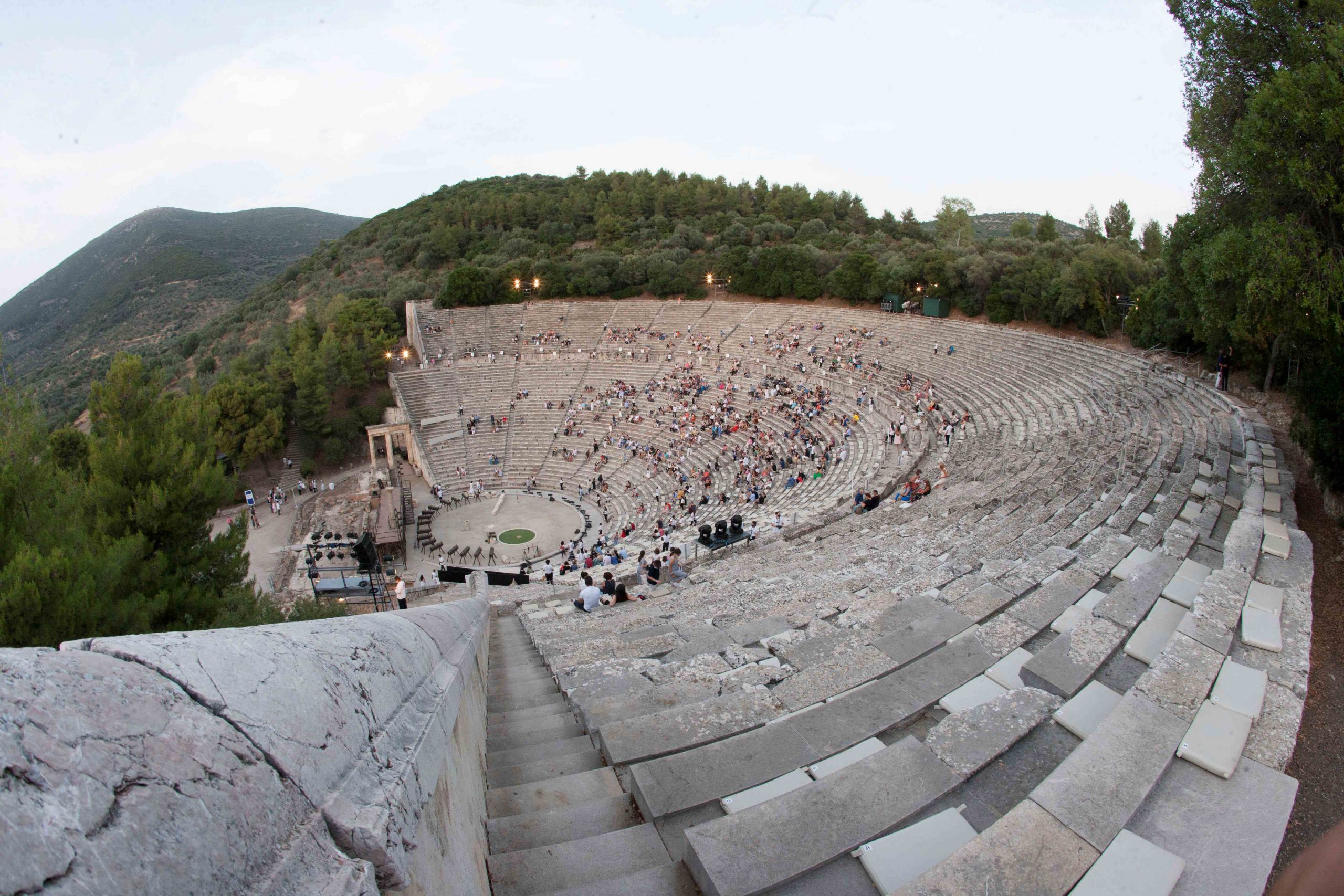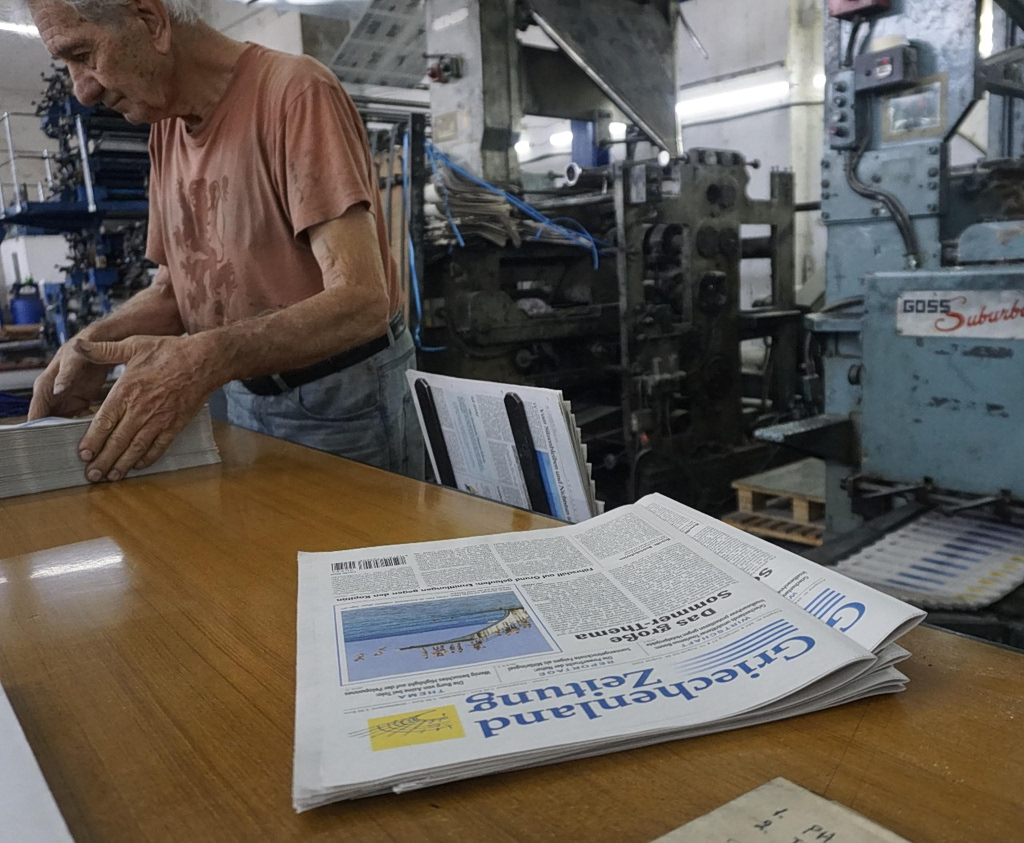A “Hermes” and an “omphalos” in the shadow of the Acropolis
The installation of Athens’ new gas distribution network provided the occasion for the Greek Ministry of Culture’s archaeological services to uncover a headless male statue in marble of the Hermes Ludovisi type just one meter down in a trench dug at the junction of Erechthiou and Kallisperi streets. It was found within a structure built of rectangular bricks and could possibly have adorned one of the many villas that were built to the south of the Acropolis during the period of imperial Roman rule (1st-5th century AD). These elegant structures were decorated with sculptures—works of the Neo-Attic workshops—and elaborate mosaics. A few days later, fragments of sculptures—legs and arms which are probably related to the statue of Hermes, the torso of a second life-size male statue—were recovered from the same trench, along with parts of a figurine and a large number of lamps dating from the 5th century AD. A section of the sculpture that at first sight seems to have elements in common with the Delphic omphalos—the stone Zeus placed to mark the center or navel of the world—has caused a particular stir. Marble, oval in shape, and with the characteristic knotted woolen net carved in relief on its surface, the omphalos is a symbol of Apollo’s divine power.
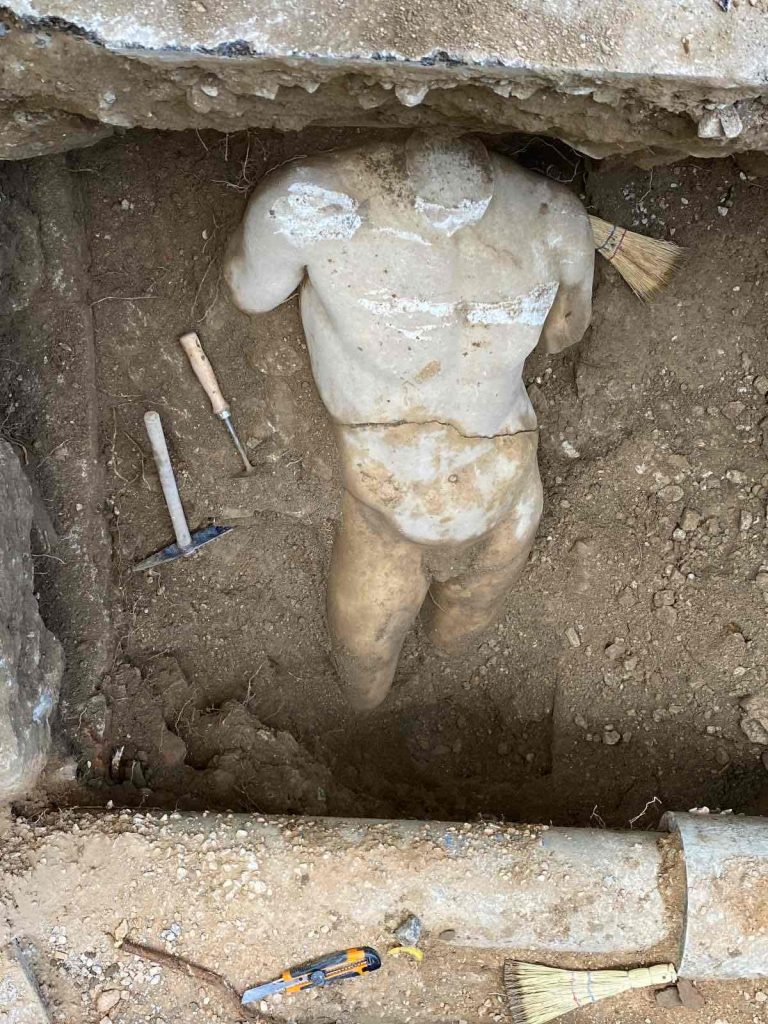
Prehistoric ritual quarry on Cephalonia
One of the earliest flint quarries in Greece, and the only one of its kind found to date from the late Bronze Age (around 1,100 BC), the site consists of two five-meter-deep wells and a man-made terrace. It was discovered by the archaeologists of Cephalonia’s Ephorate of Antiquities just outside Argostoli. Archaeologists believe the structures were linked to rituals celebrated on the island. It is interesting that a company that today mines the purest calcium carbonate in the world should be operating in the same foothills where this prehistoric landmark was discovered (flint is found in limestone deposits). It also testifies to the continuation of the same activity on the same site 3,100 years later!
A previously unknown “labyrinth” from Crete’s Minoan past
A unique and as yet unidentified archaeological find which came to light thanks to the new radar at Heraklion Airport is expected to write a new page in the history of Crete’s Minoan past: a monumental architectural group, circular in shape and resembling a labyrinth at first sight, at an altitude of 494 meters at the summit of Papoura Hill in the Kastelli area. The monumental structure has an intricate floor plan covering 1,800 sq.m. and consists of superimposed stone rings—with an average thickness is 1.40 m and a maximum estimated height of 1.70 m—on multiple levels. The central section was probably domed (given that the walls lean in toward the center), while the rooms around the perimeter may well have had flat roofs. It is built on three separate levels, because the structure is at the very top of the hill and is actually built into its summit. It dates back to the start of the Protopalatial period—around 1900 BC—and was found in during exploratory excavations being carried out by the local ephorate of antiquities ahead of the installation of a radar system for the new airport whose runway is about 1 km away. It is believed to have been associated with cult practices.
A talisman that changes our understanding of history
The history of the spread of Christianity is being rewritten by a small silver amulet just 3.5 cm long that concealed within it a mysterious 18-verse text. It came to light in the Frankfurt area and is, according to scientists, the oldest evidence found to date of Christianity’s spread north of the Alps in the late Roman period. It proves that Christianity had reached the region some 50 to 100 years earlier than previously believed. The amulet was discovered in 2018 in a tomb dating from between AD 230 and 270 in the Heilmannstrasse cemetery, just outside Frankfurt. The grave belonged to a man and contained grave goods including an incense burner and a vase. The small silver amulet was found under the man’s chin, as he apparently wore it on a cord around his neck. Advances in sophisticated X-ray and CT technology only made it possible to read the rolled-up parchment inside the amulet last May, when it was revealed that the text, which is written entirely in Latin, includes a passage from the Christ Hymn which Saint Paul included in his letter to the Philippians.
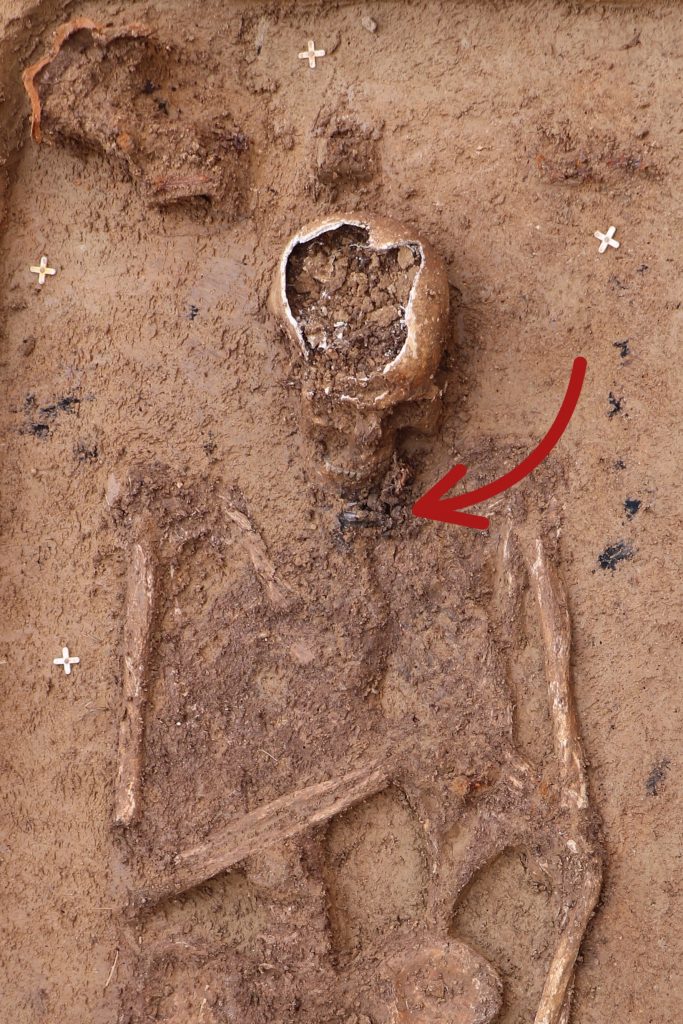
Denkmalamt Stadt Frankfurt am Main Foto Michael Obst
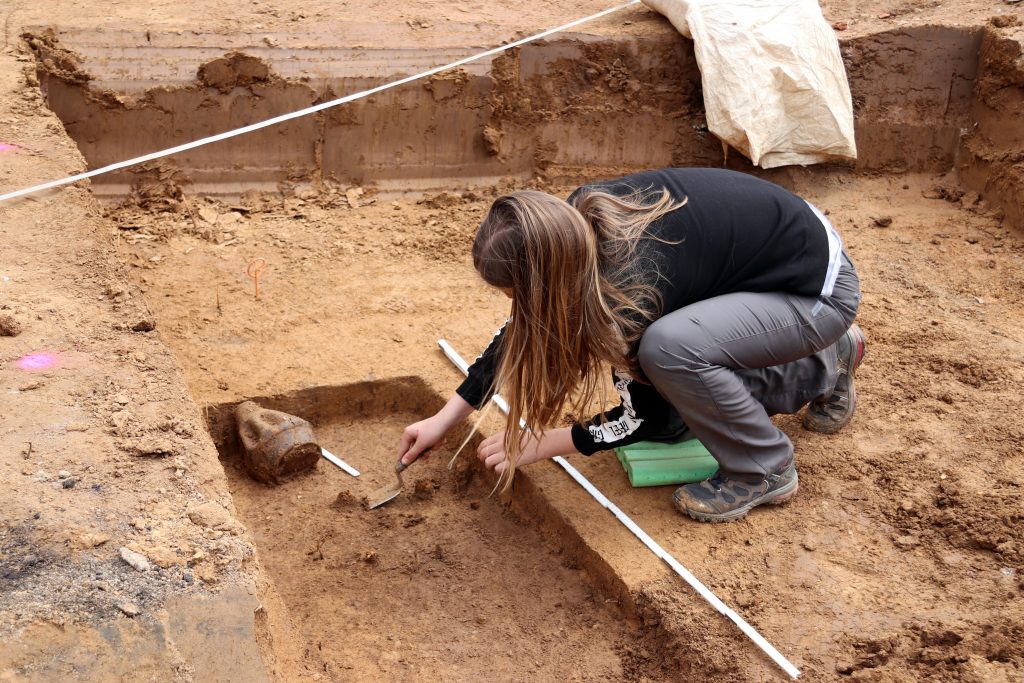
Denkmalamt Stadt Frankfurt am Main Foto Michael Obst
They buried it to save it
The marble statue of Hermes brought to light by archaeologists in a Roman sewer in Herakleia Sintica, an ancient Greek city founded by Alexander’s father Philip II in 356-339 BC and abandoned in the 6th century AD, is a full two meters high. The well-preserved statue—a Roman copy of an ancient Greek original—is thought to have been carefully buried in antiquity. The larger-than-lifesize sculpture, which has survived with just a few bumps to its arms, is thought to have been buried by worshippers of the Ancient Greek gods to protect— it not only from the righteous fury of Christians, but also from an earthquake that struck the best-preserved ancient city excavated in Bulgaria to date in 388 AD.
Ashes reveal Plato’s secrets
The night before his death, Plato listened to a Thracian slave playing the flute. Thoroughly unimpressed by her performance, he criticized her sense of rhythm. On the same day he entertained a “Chaldean visitor”, probably in his private quarters within the Academy, despite suffering from an intermittent fever. We know this thanks to a charred scroll containing the text of Philodemus of Gadara’s “History of the Academy”, which scientists have now managed to decipher with the help of AI. The same papyrus mentions the precise location of his burial in the grounds of his beloved Academy, beside the “Temple of the Muses”, as well as details on when exactly he was sold as a slave: in 404 BC, when the Spartans conquered Aegina, or perhaps in 399 BC, immediately after Socrates’ death—not in 387 BC as was believed until now. The scroll in question was found in the “Villa of Papyri” in Herculaneum, which, like Pompeii was destroyed by volcanic ash after the eruption of Vesuvius in 79 AD.
The world’s oldest lipstick was red
Four-thousand-year-old lipstick has been recovered from a tiny vial found in south-eastern Iran. A deep red mixture of minerals—mainly hematite, mixed with manganite, braunite and waxy ingredients of vegetal origin—was found in a stone tube and is “probably the oldest” sample of lipstick to have ever been scientifically analyzed. Surprisingly, both the brightness of the red mineral pigments and the waxy substances are fully compatible with modern lipsticks. The shape of the vial and its contents suggest that it was used on the lips, but it may have been used as a combined lipstick and blusher.
Our sole portrait of the last Byzantine emperor
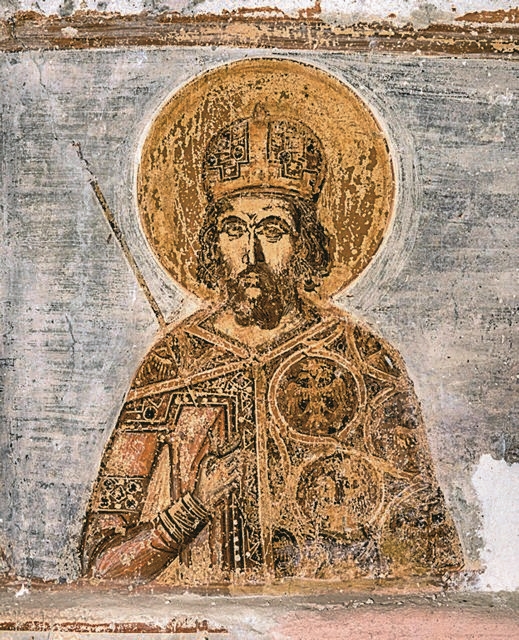
A painting in the church of Old Taxiarches Monastery in Aegialia, on the north shore of the Peloponnese, has been identified by the Achaia Ephorate of Antiquities as a portrait of Constantine XI Palaeologus. This makes it the only depiction found to date of the face of the last emperor of Byzantium. The portrait of the emperor, which was discovered during conservation work on the wall paintings in the church and dates from the mid-15th century, depicts a mature man with a thin face and personalized features. He exudes a calm nobility. Experts believe the portrait was painted while Constantine XI Palaiologos was still alive by an artist who had seen him in person. And despite the lack of an inscription, its identity is revealed, the experts argue, by the imperial symbols it bears along with the emperor’s royal scepter.
They “touched” the Antikythera wreck
Archaeologists have had hands-on contact with the hull of the ship that was carrying the enigmatic Antikythera Mechanism when it sank, along with one of Greek antiquity’s most masterful bronze sculptures, the famous 4th-century BC statue of a youth known as the Antikythera Ephebe. The important and unexpected find was found at a depth of 47.3 m and is preserved in excellent condition. It is a section of the hull with a small number of the wooden planks that formed the outer shell still attached. They are covered with a protective lead covering, the so-called sheath. The excavation is taking place on one of the most famous and richest shipwrecks of antiquity, the cargo transport which sank in the 1st century BC off the island of Antikythera. Accidentally discovered by sponge divers from nearby Syros 124 years ago, it has already yielded some 300 movable finds, including 21 marble fragments (18 statue parts) and 200 pottery sherds.
Pompeii still has some surprises up its (transparent) sleeve
No one ever imagined the mythical Phaedra residing in a Pompeii home so humble it lacked an atrium, yet there she is her transparent clothes, faithful Nurse at her side and, opposite her, naked, the object of her forbidden desires: her stepson Hippolytus. Phaedra was not the only inhabitant of this particular house, however. The frescoes on its walls depict other scantily-clad figures, including a satyr with a nymph, Aphrodite and Adonis, and Paris judging a competition that will come back to haunt him. Experts believe the house was still under construction when Mount Vesuvius erupted in 79 AD, burying the entire city under volcanic ash.
